I-Cache
I-Cache总的来讲比较简单,因为与内存的交互只有读入。
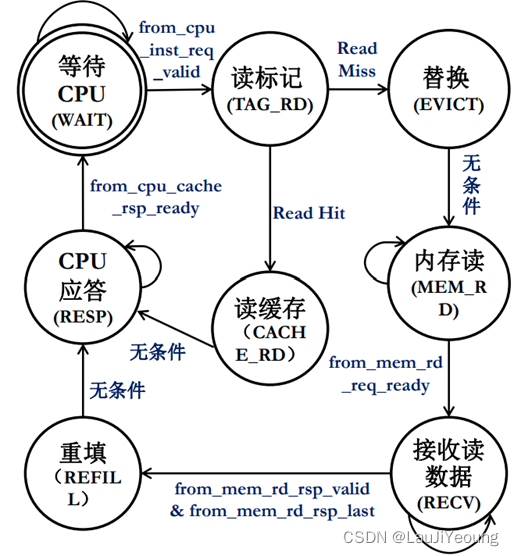
按照流程,写出自动机即可:
define WAIT 8'b00000001 define TAG_RD 8’b00000010
define EVICT 8'b00000100 define MEM_RD 8’b00001000
define RECV 8'b00010000 define REFILL 8’b00100000
define CACHE_RD 8'b01000000 define RESP 8’b10000000
always @ (posedge clk)begin
if(rst == 1’b1)begin
current_state<=`WAIT;
end
else begin
current_state<=next_state;
end
end
always @ (*)begin
case(current_state)
`WAIT :begin
if(from_cpu_inst_req_valid)
next_state = `TAG_RD;
else
next_state = `WAIT;
end
`TAG_RD :begin
if(Read_Hit)
next_state = `CACHE_RD;
else
next_state = `EVICT;
end
`EVICT :begin
next_state = `MEM_RD;
end
`MEM_RD :begin
if(from_mem_rd_req_ready)
next_state = `RECV;
else
next_state = `MEM_RD;
end
`RECV :begin
if(from_mem_rd_rsp_valid & from_mem_rd_rsp_last)
next_state = `REFILL;
else
next_state = `RECV;
end
`REFILL :begin
next_state = `RESP;
end
`CACHE_RD :begin
next_state = `RESP;
end
`RESP :begin
if(from_cpu_cache_rsp_ready)
next_state = `WAIT;
else
next_state = `RESP;
end
default: next_state = current_state;
endcase
end
总的来讲,ICache没有什么难点,按照题意设计四个way的Tag和Data的专用寄存器堆,然后再判断当前的块是在哪个位置即可:
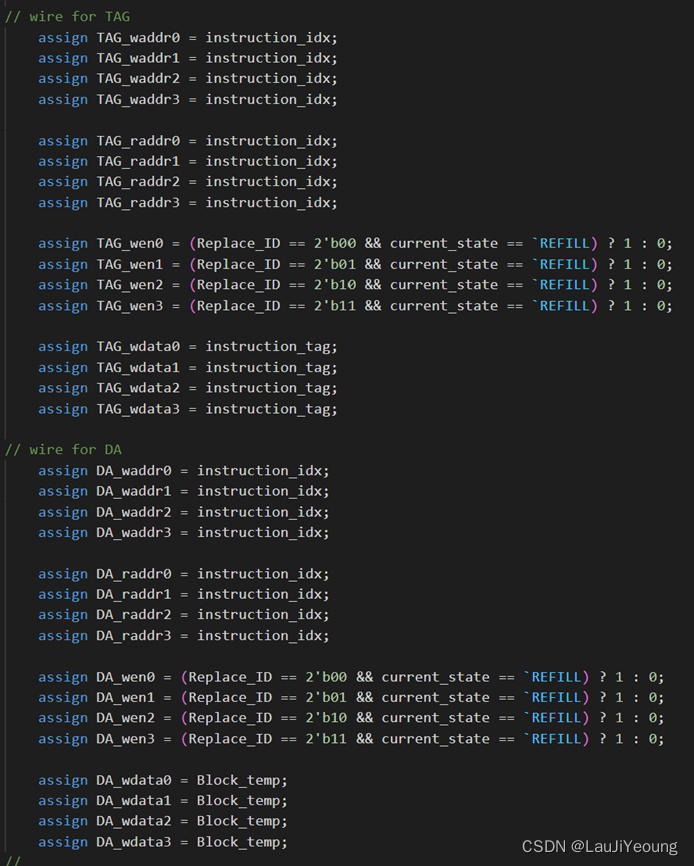
唯一值得注意的是写入地址的设计,即Replace_ID的设计,我的设计是循环写入,即先写way0,way1…way3最后又来写way0。
另外一个值得注意的点是burst操作:
always @ (posedge clk) begin
if(current_state == `MEM_RD && from_mem_rd_req_ready)
len <= 0;
else
if(current_state == `RECV && from_mem_rd_rsp_valid)
len <= len + 1;
end
always @ (posedge clk) begin
if(current_state == `RECV && from_mem_rd_rsp_valid) begin
case(len)
3'b000 : begin
Block_temp [ 31: 0]<= from_mem_rd_rsp_data;
end
3'b001 : begin
Block_temp [ 63: 32]<= from_mem_rd_rsp_data;
end
3'b010 : begin
Block_temp [ 95: 64]<= from_mem_rd_rsp_data;
end
3'b011 : begin
Block_temp [127: 96]<= from_mem_rd_rsp_data;
end
3'b100 : begin
Block_temp [159:128]<= from_mem_rd_rsp_data;
end
3'b101 : begin
Block_temp [191:160]<= from_mem_rd_rsp_data;
end
3'b110 : begin
Block_temp [223:192]<= from_mem_rd_rsp_data;
end
3'b111 : begin
Block_temp [255:224]<= from_mem_rd_rsp_data;
end
endcase
end
end
对于这一块,我是这么考虑的:我按照教案的解释设计了一个len的register用来统计当前的长度,然后利用当前的len来选数,写进读入的Block。
最后读出部分就比较简单了,如果是hit,就用寄存器读出的值,否则就用从内存得到的值即可:
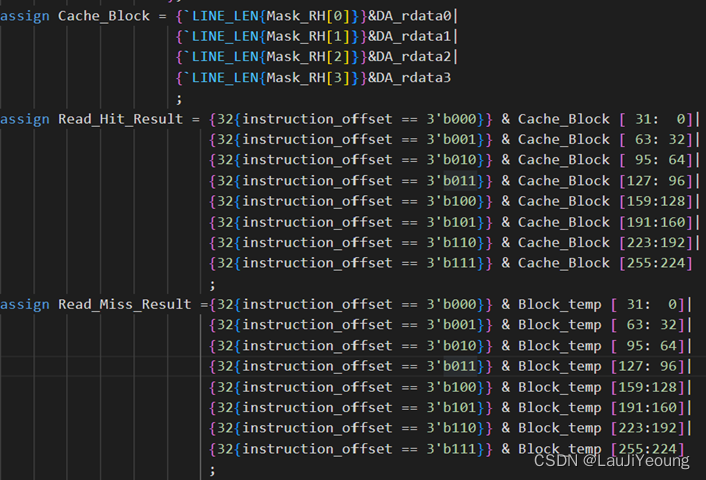
这里是使用地址的低2-4位进行选数,因为这是按照byte存储的。
其余的一些小细节是:

再WAIT阶段要把两个WAIT信号拉高,传给内存的地址要是BLOCK的首位地址。
D-Cache
D-Cache总的来讲就比较复杂了,为此我设计了16种独热码:
`define D_WAIT 16'b0000000000000001
`define D_JUDGE 16'b0000000000000010
`define D_CACHE_RD 16'b0000000000000100
`define D_RESP 16'b0000000000001000
`define D_EVICT 16'b0000000000010000
`define D_MEM_WB 16'b0000000000100000
`define D_MEM_RD 16'b0000000001000000
`define D_RECV 16'b0000000010000000
`define D_REFIL 16'b0000000100000000
`define D_CACHE_WB 16'b0000001000000000
`define D_IO_RECV 16'b0000010000000000
`define D_IO_RESP 16'b0000100000000000
`define D_IO_WB 16'b0001000000000000
`define D_IO_RD 16'b0010000000000000
`define D_IO_REQ 16'b0100000000000000
`define D_MEM_REQ 16'b1000000000000000
状态转移图如下:
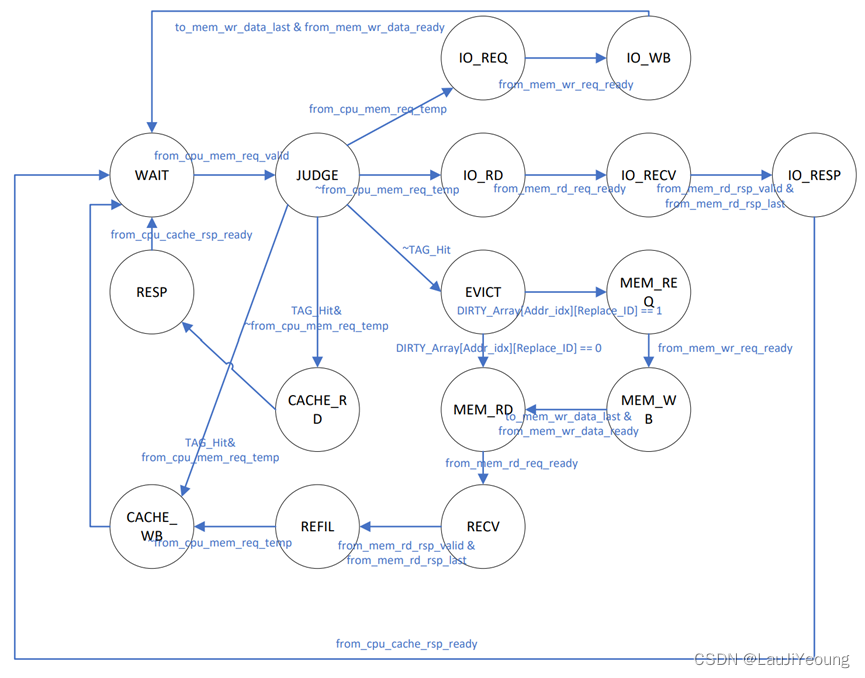
总的来讲,这个状态转移设计的比较臃肿,对于旁路部分,将读和写分开来写,读的部分直接模仿ICache的状态转移图即可。对于写,按照要求,必须先传REQ再传数据,所以需要两个状态。
对于非旁路部分,则有四种情况,如果是命中的读,则和ICache一样,如果是命中的写,也比较简单,直接往内部写即可。对于未命中,由于采用Write
Allocate策略,所以全部进入替换策略。如果发现Cache内容已经被改写,则依旧是经过一个REQ和WB过程进行写回。
随后和ICache一摸一样的进行读入,到REFIL,如果是写操作则改写,否则还是和CPU握手后传回数据。
具体实现:
always @ (posedge clk)begin
if(rst == 1'b1)begin
current_state<=`D_WAIT;
end
else begin
current_state<=next_state;
end
end
always @ (*)begin
case(current_state)
`D_WAIT :begin
if(from_cpu_mem_req_valid)
next_state = `D_JUDGE;
else
next_state = `D_WAIT;
end
`D_JUDGE :begin
if(op_IO)begin
if(from_cpu_mem_req_temp)
next_state = `D_IO_REQ;
else
if(~from_cpu_mem_req_temp)
next_state = `D_IO_RD;
else
next_state = `D_JUDGE;
end
else begin
if(~from_cpu_mem_req_temp)begin
if(TAG_Hit)
next_state = `D_CACHE_RD;
else
next_state = `D_EVICT;
end
else begin
if(TAG_Hit)
next_state = `D_CACHE_WB;
else
next_state = `D_EVICT;
end
end
end
`D_CACHE_RD :begin
next_state = `D_RESP;
end
`D_RESP :begin
if(from_cpu_cache_rsp_ready)
next_state = `D_WAIT;
else
next_state = `D_RESP;
end
`D_EVICT :begin
if(DIRTY_Array[Addr_idx][Replace_ID] == 1)
next_state = `D_MEM_REQ;
else
if(DIRTY_Array[Addr_idx][Replace_ID] == 0)
next_state = `D_MEM_RD;
else
next_state = `D_EVICT;
end==
`D_MEM_REQ :begin
if(from_mem_wr_req_ready)
next_state = `D_MEM_WB;
else
next_state = `D_MEM_REQ;
end
`D_MEM_WB :begin
if(to_mem_wr_data_last & from_mem_wr_data_ready)
next_state = `D_MEM_RD;
else
next_state = `D_MEM_WB;
end
`D_MEM_RD :begin
if(from_mem_rd_req_ready)
next_state = `D_RECV;
else
next_state = `D_MEM_RD;
end
`D_RECV :begin
if(from_mem_rd_rsp_valid & from_mem_rd_rsp_last)
next_state = `D_REFIL;
else
next_state = `D_RECV;
end
`D_REFIL :begin
if(~from_cpu_mem_req_temp)
next_state = `D_RESP;
else
next_state = `D_CACHE_WB;
end
`D_CACHE_WB :begin
next_state = `D_WAIT;
end
`D_IO_RD :begin
if(from_mem_rd_req_ready)
next_state = `D_IO_RECV;
else
next_state = `D_IO_RD;
end
`D_IO_RECV :begin
if(from_mem_rd_rsp_valid & from_mem_rd_rsp_last)
next_state = `D_IO_RESP;
else
next_state = `D_IO_RECV;
end
`D_IO_REQ :begin
if(from_mem_wr_req_ready)
next_state = `D_IO_WB;
else
next_state = `D_IO_REQ;
end
`D_IO_WB :begin
if(to_mem_wr_data_last & from_mem_wr_data_ready)
next_state = `D_WAIT;
else
next_state = `D_IO_WB;
end
`D_IO_RESP :begin
if(from_cpu_cache_rsp_ready)
next_state = `D_WAIT;
else
next_state = `D_IO_RESP;
end
default: next_state = current_state;
endcase
end
其余大部分内容都是一样的,唯一比较特别的是替换操作,我的实现比较繁琐,具体思路是从Cache中取出所需要的Block,然后再取出所需要的Byte,接着再得到修改后的Byte,最后又拼回所需要的Block。

另外一个比较特殊的地方是Burst写的时候的信号问题,这实际上也不是很难:
第一是一定要用Tag专用寄存器拼接出对应的地址,而不是误用读入的地址:

其次是在读出数据的时候对8个Byte的位置需要进行选数:
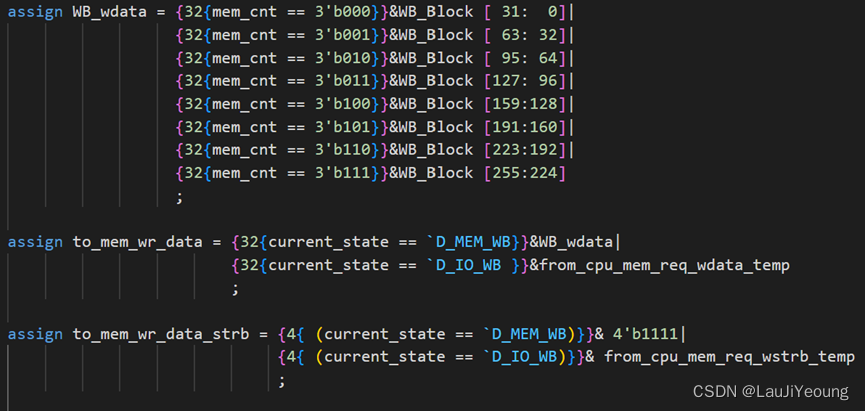
对于握手信号,注意在最后一拍拉高:






















 1452
1452











 被折叠的 条评论
为什么被折叠?
被折叠的 条评论
为什么被折叠?








